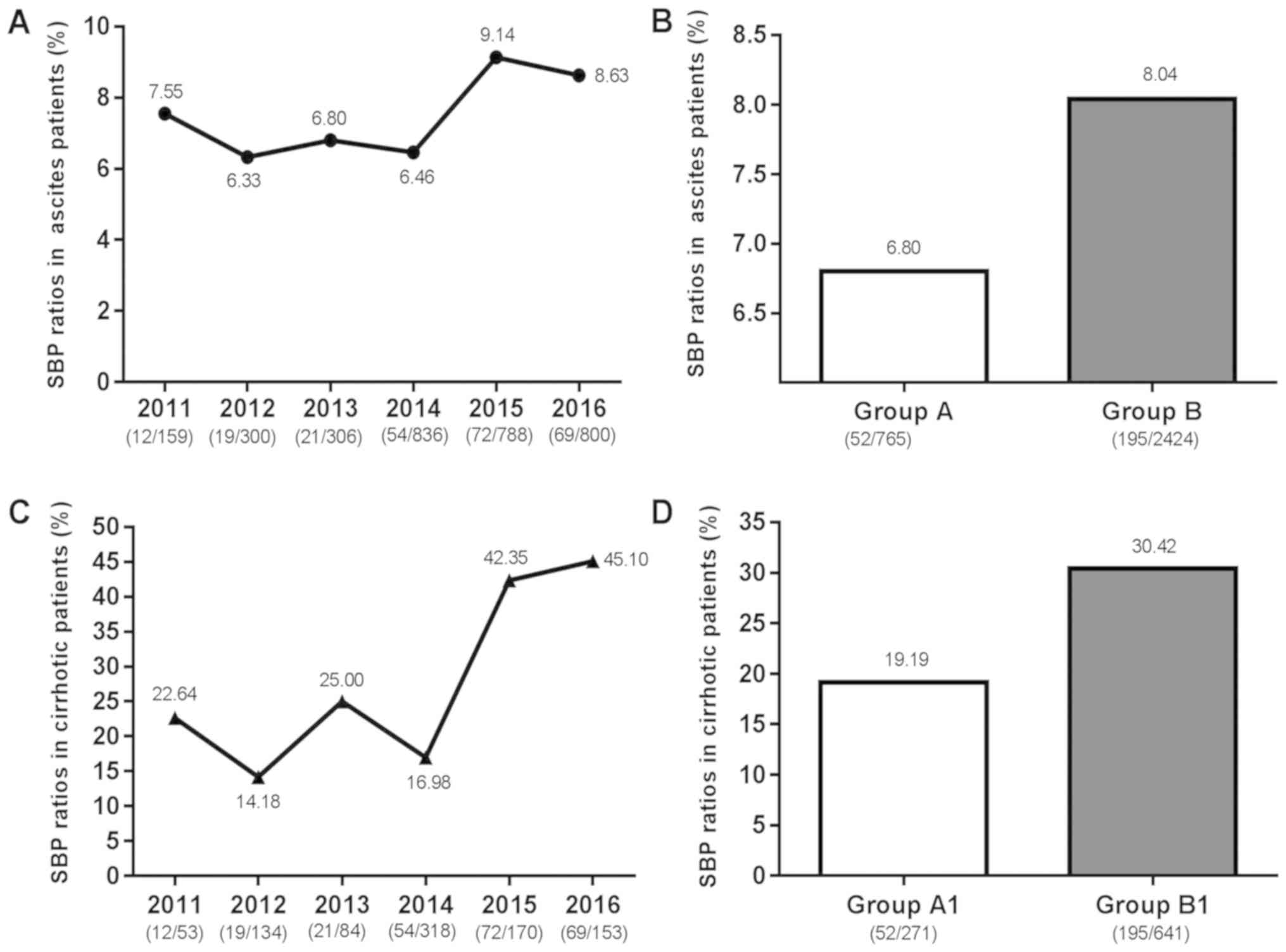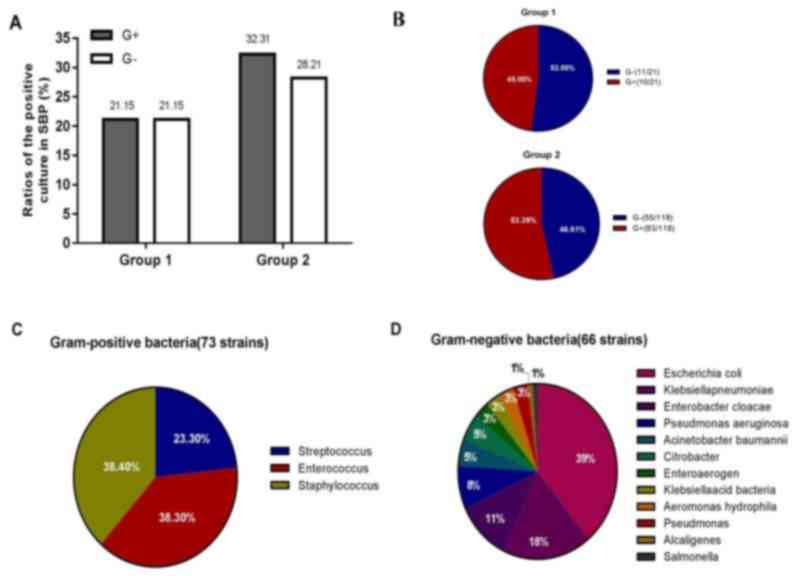|
1
|
Tsochatzis EA, Bosch J and Burroughs AK:
Liver cirrhosis. Lancet. 383:1749–1761. 2014. View Article : Google Scholar : PubMed/NCBI
|
|
2
|
Fiore M, Maraolo AE, Gentile I, Borgia G,
Leone S, Sansone P, Passavanti MB, Aurilio C and Pace MC: Current
concepts and future strategies in the antimicrobial therapy of
emerging Gram-positive spontaneous bacterial peritonitis. World J
Hepatol. 9:1166–1175. 2017. View Article : Google Scholar : PubMed/NCBI
|
|
3
|
Cui Y and Jia J: Update on epidemiology of
hepatitis B and C in China. J Gastroenterol Hepatol. 28 (Suppl
1):S7–S10. 2013. View Article : Google Scholar
|
|
4
|
Enomoto H, Inoue S, Matsuhisa A and
Nishiguchi S: Diagnosis of spontaneous bacterial peritonitis and an
in situ hybridization approach to detect an ‘unidentified’
pathogen. Int J Hepatol. 2014:6346172014. View Article : Google Scholar : PubMed/NCBI
|
|
5
|
Kim JH, Jeon YD, Jung IY, Ahn MY, Ahn HW,
Ahn JY, Ku NS, Han SH, Choi JY, Ahn SH, et al: Predictive factors
of spontaneous bacterial peritonitis caused by gram-positive
bacteria in patients with cirrhosis. Medicine (Baltimore).
95:e34892016. View Article : Google Scholar : PubMed/NCBI
|
|
6
|
Paul K, Kaur J and Kazal HL: To study the
incidence, predictive factors and clinical outcome of spontaneous
bacterial peritonitis in patients of cirrhosis with ascites. J Clin
Diagn Res. 9:OC09–OC12. 2015.PubMed/NCBI
|
|
7
|
Yan K and Garcia-Tsao G: Novel prevention
strategies for bacterial infections in cirrhosis. Expert Opin
Pharmacother. 17:689–701. 2016. View Article : Google Scholar : PubMed/NCBI
|
|
8
|
Fukui H: Gut Microbiome-based therapeutics
in liver cirrhosis: Basic consideration for the next step. J Clin
Transl Hepatol. 5:249–260. 2017.PubMed/NCBI
|
|
9
|
Runyon BA: Management of adult patients
with ascites due to cirrhosis: Update 2012. American Association
for the Study of Liver Diseases. 2012, https://www.aasld.org/sites/default/files/guideline_documents/adultascitesenhanced.pdfMay
6–2012
|
|
10
|
European Association for the Study of the
Liver, . EASL clinical practice guidelines on the management of
ascites, spontaneous bacterial peritonitis, and hepatorenal
syndrome in cirrhosis. J Hepatol. 53:397–417. 2010. View Article : Google Scholar : PubMed/NCBI
|
|
11
|
Clinical and Laboratory Standards
Institute (CLSI), . Reference Method for Broth Dilution Antifungal
Susceptibility Testing of Yeasts. 4th. CLSI standard M27. CLSI;
Wayne, PA: 2017
|
|
12
|
Bal CK, Daman R and Bhatia V: Predictors
of fifty days in-hospital mortality in decompensated cirrhosis
patients with spontaneous bacterial peritonitis. World J Hepatol.
8:566–572. 2016. View Article : Google Scholar : PubMed/NCBI
|
|
13
|
Wong F: Acute kidney injury in liver
cirrhosis: New definition and application. Clin Mol Hepatol.
22:415–422. 2016. View Article : Google Scholar : PubMed/NCBI
|
|
14
|
Cholongitas E, Papatheodoridis GV, Lahanas
A, Xanthaki A, Kontou-Kastellanou C and Archimandritis AJ:
Increasing frequency of Gram-positive bacteria in spontaneous
bacterial peritonitis. Liver Int. 25:57–61. 2005. View Article : Google Scholar : PubMed/NCBI
|
|
15
|
Yang Y, Li L, Qu C, Zeng B, Liang S, Luo
Z, Wang X and Zhong C: Diagnostic accuracy of serum procalcitonin
for spontaneous bacterial peritonitis due to end-stage liver
disease: A Meta-analysis. Medicine (Baltimore). 94:e20772015.
View Article : Google Scholar : PubMed/NCBI
|
|
16
|
de Mattos AA, Costabeber AM, Lionco LC and
Tovo CV: Multi-resistant bacteria in spontaneous bacterial
peritonitis: A new step in management? World J Gastroenterol.
20:14079–14086. 2014. View Article : Google Scholar : PubMed/NCBI
|
|
17
|
Hatami B, Ashtari S, Sharifian A, Rahmani
Seraji H, Khalili E, Hatami Y and Zali MR: Changing the cause of
liver cirrhosis from hepatitis B virus to fatty liver in Iranian
patients. Gastroenterol Hepatol Bed Bench. 10 (Suppl):S20–S26.
2017.PubMed/NCBI
|
|
18
|
Li YT, Yu CB, Huang JR, Qin ZJ and Li LJ:
Pathogen profile and drug resistance analysis of spontaneous
peritonitis in cirrhotic patients. World J Gastroenterol.
21:10409–10417. 2015. View Article : Google Scholar : PubMed/NCBI
|
|
19
|
Xie Y, Tu B, Zhang X, Bi J, Shi L, Zhao P,
Chen W, Liu S, Xu D and Qin E: Investigation on outcomes and
bacterial distributions of liver cirrhosis patients with
gram-negative bacterial bloodstream infection. Oncotarget.
9:3980–3995. 2018. View Article : Google Scholar : PubMed/NCBI
|
|
20
|
Kim T, Hong SI, Park SY, Jung J, Chong YP,
Kim SH, Lee SO, Kim YS, Woo JH, Lim YS, et al: Clinical features
and outcomes of spontaneous bacterial peritonitis caused by
streptococcus pneumoniae: A matched Case-control study. Medicine
(Baltimore). 95:e37962016. View Article : Google Scholar : PubMed/NCBI
|
|
21
|
Acevedo J: Multiresistant bacterial
infections in liver cirrhosis: Clinical impact and new empirical
antibiotic treatment policies. World J Hepatol. 7:916–921. 2015.
View Article : Google Scholar : PubMed/NCBI
|
|
22
|
Karkmann K, Piecha F, Runzi AC, Schulz L,
von Wulffen M, Benten D, Kluwe J and Wege H: Management of
compensated liver cirrhosis 2018-Evidence based prophylactic
measures. Z Gastroenterol. 56:55–69. 2018.(In German). PubMed/NCBI
|
















